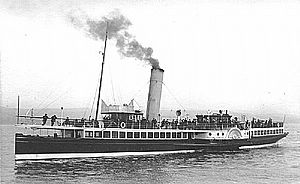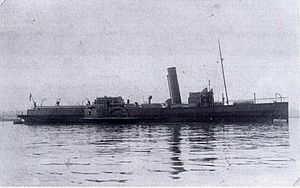PS Duchess of Montrose facts for kids

Paddle Steamer Duchess of Montrose in pre-war livery
|
|
| History | |
|---|---|
| Name | PS Duchess of Montrose |
| Namesake | Violet Hermione Graham (1854-1940), Duchess of Montrose |
| Owner | |
| Ordered | 29 November 1901 |
| Builder | John Brown & Company, Clydebank |
| Cost | £19,572 |
| Yard number | 352 |
| Laid down | 19 December 1901 |
| Launched | 8 May 1902 |
| Fate | Requisitioned by the Royal Navy, 15 February 1915 |
| Operator | |
| Acquired | 15 February 1915 |
| Identification | Pennant number: PP585 |
| Fate | Mined near Gravelines, 18 March 1917 |
| General characteristics | |
| Class and type | Clyde paddle steamer |
| Tonnage | 322 tons |
| Length | 210.3 ft (64.1 m) |
| Beam | 25.2 ft (7.7 m) |
| Installed power | 206 nominal horsepower |
| Propulsion | Four-cylinder triple-expansion diagonal steam engine, driving paddles |
| Speed | 16.5 kn (30.6 km/h) |
The PS Duchess of Montrose was a special kind of ship called a paddle steamer. She was built in 1902. Her job was to take people on fun trips along the River Clyde in Scotland.
During the First World War, the ship was taken over by the Navy. They turned her into a minesweeper, which is a ship that clears dangerous underwater bombs called mines. Sadly, she was lost near Dunkirk on March 18, 1917, after hitting a mine.
Contents
Building the Duchess of Montrose
In October 1901, a company called Caledonian Steam Packet Company wanted a new paddle steamer. They asked six shipyards on the Clyde River to offer their ideas and prices.
On October 29, 1901, they chose John Brown & Company from Clydebank. This company agreed to build the ship for £19,572. The building of the ship started on December 19, 1901.
The company decided to name the new ship Duchess of Montrose. They got permission from the Duchess of Montrose herself. The ship was officially launched into the water on May 8, 1902. She passed all her speed tests on June 4, 1902.
How the Ship Was Designed
The Duchess of Montrose had a powerful steam engine. It had four cylinders that worked together to make the paddle wheels turn. This design was very efficient. It also made the ship easier to steer when docking at piers.
The ship had smaller paddle wheels than usual. This meant her paddleboxes (the covers over the wheels) were not very big. She also had a very straight, tall funnel. These features made her easy to spot among other ships on the Clyde.
Inside, she had comfortable rooms for passengers at the front and back. There was also an open area at the front under the top deck where people could enjoy the view.
The Ship's Jobs
Fun Excursion Trips
The Duchess of Montrose first worked from Ayr. Later, she carried passengers on routes from Gourock and Wemyss Bay. She also helped connect people to railway lines further up the river.
Carrying Troops
On February 15, 1915, the Navy took over the Duchess of Montrose. Two other ships, Duchess of Argyll and Duchess of Hamilton, were also taken. The Duchess of Montrose became a troopship.
For the first few months, she carried soldiers from Southampton to France. When she first arrived in Southampton, she was still in her original company colours. But soon, she was painted grey, like other Navy ships.
Clearing Mines
On May 15, 1915, the Duchess of Montrose was given a special Navy number: PP585. She was then changed into a minesweeper. This meant part of her passenger area was removed. Special equipment for sweeping mines was put in its place.
From July 14, 1915, she was based in Dover. Later, from April 1916, she was stationed in Dunkirk.
Helping to Save the Sussex
Between January 1 and 3, 1917, the Duchess of Montrose helped with a big rescue. She and several other ships worked together to save the steamer Sussex. The Sussex had hit a mine near the West Dyck shoal while sailing to Dunkirk.
All the ships that helped received some money for their efforts.
The Ship's Final Moments
On Sunday, March 18, 1917, the Duchess of Montrose left Dunkirk harbour. At 9 AM, she started sweeping for mines near the Gravelines Buoy. She found and removed five mines that had been placed by a German submarine.
She stopped for a while because the water level was low. About an hour after she started sweeping again, the Duchess of Montrose hit another mine. The mine exploded in the middle of the ship. She broke in two and sank very quickly, in less than a minute. Her wreck is now located at 51°03′N 2°07′E / 51.050°N 2.117°E.
Thirty-one of the ship's crew members were saved. However, twelve brave men were lost when the ship sank.


